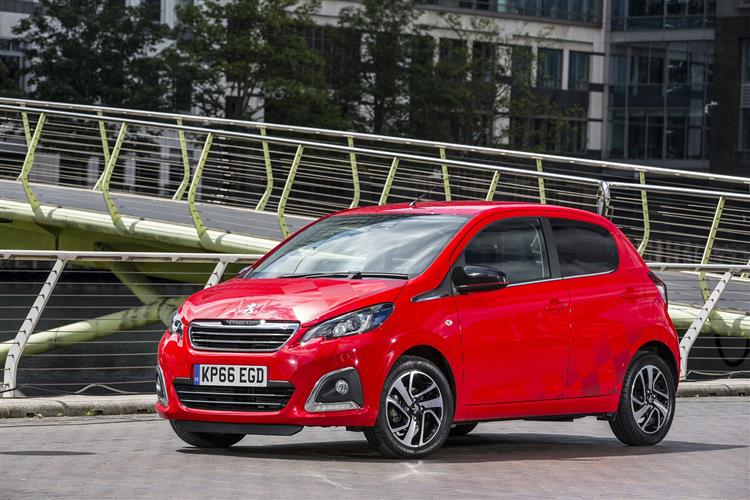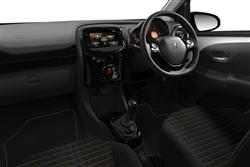This is a sample, showing 30 seconds of each section.
SMALL BUT SENSIBLE (some text hidden) SECTIONED_peugeot108_060814
By Jonathan Crouch
Introductionword count: 64
Peugeot's 108 demonstrated back in 2014 just how far city cars had come in recent years. In fact, this one's more sophisticated and efficient than you might ever have expected a model of this kind could be. This one was media-savvy, efficient and could even be had in open 'TOP!' form. Plus it was very personalisable. Let's check it out as a used buy.
Modelsword count: 13
5dr city car (1.0, 1.2 petrol) [Active, Access, Allure, Collection, Feline, GT Line]
Historyword count: 272
Creating a city car is hard enough. Trying to differentiate a design shared with other brands must be even more difficult. Such was Peugeot's job with this car, the 108. The French manufacturer has a long history in the market's smallest segment stretching all the way back to the 104 model of 1972. From 2005 onwards though, it shared its presence in this sector with sister company Citroen and their C1 and Toyota with their Aygo. This trio of brands together created a single city car design tweaked in each case to their own individual preferences. And established a Czech Republic factory to affordably build it for the next nine years. To be frank, that period was rather over-long and by 2014, it was time for a re-think. For a car with more than one engine option, extra hi-tech, a bit more space and more complete safety provision. This 108 was that car. In all these areas, this model improved upon the standard set by its 107 predecessor - as of course did its very similar Citroen C1 and Toyota Aygo design stablemates. Of the trio, this Peugeot went for a classier, more mature look than the C1 and initially came with a 1.2-litre engine option you couldn't get in the Aygo. And all three cars were more efficient and personalisable than even the finest city runabouts from other brands. Most customers wanted this car in 1.0-litre form (that 1.2-litre engine option lasted only until 2018) and in conventional hatch guise (the 'TOP!' version with its fabric-folding roof was deleted in 2020). The 108 range sold until early 2022 and wasn't replaced.
What You Getword count: 1237
All city cars set their stall out for younger customers. The difference with this one though - and the trump card it held over its Citroen and Toyota design stablemates - is in the way that its styling was calculated to appeal to the more mature folk usually ignored in the stampede towards youth culture. As a consequence, this 108 appealed to customers who might never have previously chosen a city car because they felt such a thing would be too insubstantial and cheap. These folk saw in this Peugeot a reassuringly grown-up proposition with discreet front end treatment and assured, mature detailing. They also liked the option the TOP! version of this car offered of a full-length retractable fabric folding roof, creating that cabriolet feeling without the cost or buffeting associated with a fully-fledged convertible. It's a lovely touch - but even the standard fixed-top version has plenty of those. There's certainly very little on a 108 that looks contrived or gauche, Chief Designer Ivo Groen insisting on lots of chrome and a palette of restrained, smart colours. Take the nose section for example, bearing as it does the so-called 'floating'-style front grille that by 2014 was being applied to all the brand's most compact models, in this case flanked by hi-tech bi-focal projector lamp headlights. Further brand family cues are found at the rear in the neat lamps with their illuminated 'lion claw' signature. They complete a more cleanly-styled tailgate topped off by an integrated roof spoiler that hides the external hinges that used to look so ugly on the old 107 model. We say 'tailgate': in reality, this lifting rear section is little more than a deeply sculpted hinged back window, doubtless there to reduce the cost of manufacturing but from an ownership perspective, a feature we've never liked. Unlike a proper conventional lifting rear hatch, this opening glass panel doesn't fully cut into the bumper, so there's quite a lofty lip over which you've to lift in your shopping, even if the height of this was here reduced by 20mm in comparison to this model's predecessor. The VW up! (along with its Skoda and SEAT stablemates) suffers from the same thing for the same reason. Enough about access: what about actual luggage space, the lack of which put so many people off the previous generation version of this car. The news that this 108 was 40mm longer than that old 107 led us to hope for more in this area, but examine the small print and you'll find that all of this extra length was actually added to the front end to meet modern safety impact legislation. In fact, this car's platform was pretty much the same as it had been before, which disappointed previous Peugeot city car buyers wanting to trade up to a model with the kind of generous 250-litre-style boot space they'd have got in a rival Volkswagen up! or Hyundai i10. There was nothing like that on offer here. Still, on the positive side, cargo room did in a 108 usefully rise from the feeble 139-litre space you previously got in a 107 to a much more acceptable 196-litre capacity - easily enough for a couple of small suitcases or a set of golf clubs. Curiously, that's nearly 30-litres more than a supposedly identical Toyota Aygo. Not that luggage space is necessarily the be-all and the end-all for customers in this class. Most of them rarely use the rear bench in their cars and therefore, have no issue in regularly pushing the 50:50 split seats forward to extend the space available. In this case, though the load area created has quite a step in it and the folded seats don't lie completely flat, you do get a very decent 868-litre capacity. If you need a greater capacity than that for your weekly shop, it might well be time to change your lifestyle rather than your car. If you are using the back seat, then you won't be expecting it to be very spacious, given that this car is just 3.4-metres in length. It isn't. Still, with a bit of co-operation from those ahead of them, two adults could manage without too much grousing on short to medium-length trips, even if they were six-footers. You might even think of cramming three kids on this bench, were it not for the fact that, rather annoyingly, there are still only two belts provided. If you do have kids, then we'd definitely go for the five-door model, rather than the three-door version. By and large, kids in this Peugeot don't mind the restricted legroom but they do tend to object to a couple of features you find on a lot of small city cars - the lack of proper wind-up rear windows (you only get an angled panel) and the slight claustrophobia engendered by the upwardly sweeping waistline of the rear door. Up front, it's reasonably easy to get comfortable, provided you've avoided an entry-level variant without seat height adjustment, something that's important to have because the steering wheel adjusts only up and down, not in and out. Settle in, then start to look around and if you've tried a few city car models from this period, you might conclude that the quality of the trim, though a step up from what was provided previously, isn't quite of the standard you'd find in, say, a Volkswagen up!. Still, the design is more interesting, which takes you mind off the fact. And it can be more interesting still, for the instrument panel, the centre console, the air vents, the gearshift knob and the gear lever surround could, from new, all easily be changed to a colour of the owner's choosing, something still possible on used models. The wide dashboard's nice, trimmed in a cool matt finish and framed by refreshingly slim A-pillars that aid visibility. Talking of visibility, if you've got a 108 with the fabric folding roof, you'll need to accept the fact that with it open in bright sunlight, a number of the interior dials and displays will be difficult to read. It'll also be pretty difficult to converse with fellow passengers at higher cruising speeds too, despite the roof system's aero-acoustic deflector. Still, we all have to pay for our pleasures don't we? Fortunately, the inside of a 108 is quite a pleasurable place to be. And quite practical too. There are two cupholders, a good-sized glovebox that incorporates a bottle-holder, practical storage options for your mobile 'phone and loose change and door bins big enough to hold a 500ml bottle of water. Ahead of you at the wheel lie a mass of different-shaped elements of trim. The round speedometer pod with its LCD central display is flanked by an optional vertically-stacked rev counter that as you accelerate, lights up like an Eighties Atari video game. Even more curiously styled is the trapezoidally-shaped central panel that holds the 7-inch infotainment colour display that Peugeot provided to dominate the centre of the dash on all but the entry-level model. This system really adds another dimension to the 108 and to be honest, we'd hesitate to buy one without it. It's operated using a fully integrated touchscreen and can include a rear view camera on plusher models. Wherever it's fitted, you get a DAB radio, along with vehicle and journey information and Bluetooth 'phone connectivity that includes the sending and receiving of texts.
To see the full road test text contact us on 0330 0020 227
Pictures (high res disabled)

.jpg)
|
.jpg)
|
.jpg)
| |||
.jpg)
|
.jpg)
|
.jpg)
| |||
.jpg)
|

|
Scoring (subset of scores)
Category: Small Runabouts
| Performance | |
| Handling | |
| Comfort | |
| Space | |
| Styling, Build, Value, Equipment, Depreciation, Handling, Insurance and Total scores are available with our full data feed. | |



